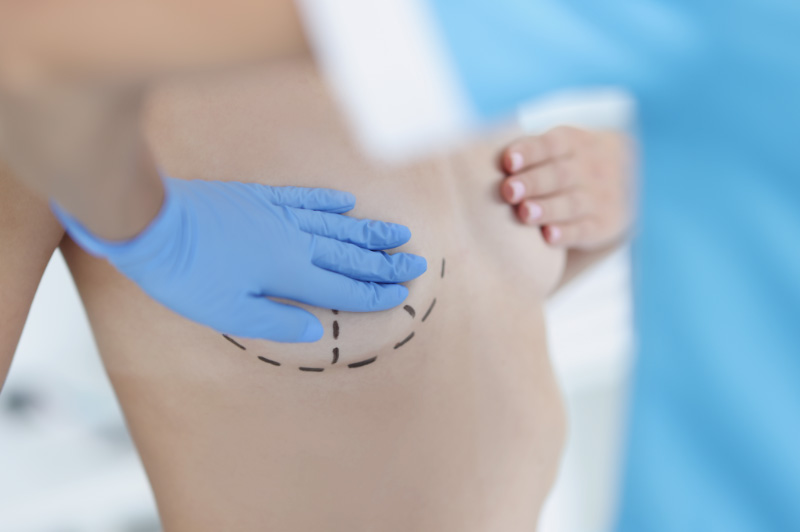
Breast augmentation is one of the most popular plastic surgery procedures in the US, with nearly 300,000 operations done in 2015. That was a 35% increase from 2000.
There are many factors to consider when getting breast augmentation, and one of the most critical is the type of incision your surgeon uses. Below is more information about the several types of breast augmentation incisions that may be used in breast implant surgery. Talk to your board certified plastic surgeon about which method he uses the most and which may be right for you.
Four Types of Incisions
There currently are four popular incision options:
- Inframammary incision: Under the breast
- Periareolar incision: Around the areola
- Transaxillary incision: In the armpit
- Transumbilical incision: Through the belly button
Inframammary Fold
Many surgeons prefer to use the inframammary incision for several reasons. First, the incision is distant from the nipple and areola, so it’s less likely to get contaminated by skin bacteria that can inhabit those areas.
Those bacteria aren’t generally harmful but some surgeons believe they can increase the chance of capsular contracture, where the implant is surrounded by scar tissue and may necessitate revision surgery.
Second, this incision gives your surgeon direct access to the chest muscle where the breast implant is placed. Also, this incision is usually required if revision surgery is needed. It makes sense to use one incision for the main surgery and have it available if a second procedure is needed.
Remember that breast implants don’t last for life, so you’ll probably need to have another surgery at some point.
Other advantages inframammary incision option are that it gives the surgeon more control over implant placement for optimal results. Also, this incision doesn’t affect nipple sensation, and there’s no worry about being able to breastfeed later.
While this is the most popular incision type, note that there is a noticeable scar. It’s usually only visible when you are lying down, but it’s something to consider.
Periareolar Incision
Periareolar Incision is also a popular incision option for breast enhancement surgery. Women have various areolar sizes, which can influence which incision is ideal in a particular case. For instance, most silicone breast implants need a 4-5 cm incision, but a saline breast implants only needs a slightly smaller incision.
Women who have a smaller areola may not be able to have a 4-5 cm incision for placing a silicone breast implants. They could need an inframammary incision or trans-axillary incision. As noted earlier, the periareolar incision option is associated with a higher breast augmentation risk of capsular contractor.
But the advantage of this option is its performed on the border of pigmented and non-pigmented skin, so the scar is hard to see.
On the downside, it isn’t appropriate if you have small nipples. Also, it makes breastfeeding more challenging because the incision involves the milk ducts. You also could have less nipple sensation.
Transaxillary Incision
Transaxillary incision is preferred by some plastic surgeons for breast augmentation procedure, but it isn’t particularly useful if revision surgery is needed. A 4-5 cm incision is made in the armpit to make the appropriate pocket for placing the implant.
This method could result in the breast implants being a bit high because it’s challenging to reach the lower part of the breast without specialized tools.
This breast augmentation incision avoids breast augmentation scars but there is a scar in the armpit that is noticeable. In cooler parts of the country, this may not matter. But in warmer areas where you may wear sleeveless blouses and tank tops, the noticeable scar may be an issue.
Some women also find they have a loss of sensation in the armpit from the incision. And this incision cannot be used if revision surgery is needed.
Transumbilical
This incision is used most rarely by plastic surgeons today. It’s made through the belly button, so the scar is almost impossible to see. It also requires the surgeon to tunnel through the abdomen to get access to the breasts.
This method isn’t used often because it’s difficult to get the breast implants placed improperly. That’s why one of the most frequent problems with this incision is an improperly placed implant. If that happens, you’ll need revision surgery, which usually requires an inframammary fold incision, anyway.
Most surgeons don’t do trans umbilical breast augmentation because of the potential for complications.
 Questions and Answers
Questions and Answers
Which breast augmentation incision options is best ?
In an inframammary incision, the surgeon makes a cut in the crease beneath the breast, providing optimal access for implant placement. This incision is particularly suitable for silicone implants, offering enhanced visibility of the breast tissue-pectoralis muscle junction.
How big are breast augmentation incisions?
The primary advantage of the approach mentioned earlier lies in the substantial reduction of the inframammary incision typically employed for saline implants. According to surgeons and textbooks, the traditional length of this incision ranges from 3 cm to 5 cm (with an average of 4.25 cm) (2–5).
How long do breast augmentation incision take to heal?
Incisions typically require complete closure within a timeframe of 2 to 4 weeks.
Contact Our office To Learn More About Breast Implants Incisions Types
If you’re thinking about breast augmentation surgery in Dallas Fort Worth, it’s essential to review the options with your plastic surgeon. Each breast augmentation incision has advantages and disadvantages, so talk it over with your surgeon to determine the best choice in your situation.
References
- Five Factors of Breast Augmentation. (n.d.). Accessed at https://www.plasticsurgery.org/news/blog/the-five-factors-of-breast-augmentation
- Breast Augmentation Guide. (n.d.). Accessed at https://www.americanboardcosmeticsurgery.org/procedure-learning-center/breast/breast-augmentation-guide/
- Is It Worth Getting Saline or Silicone implants. (n.d.). Accessed at https://www.rajamohanmd.com/is-it-worth-getting-breast-implants/